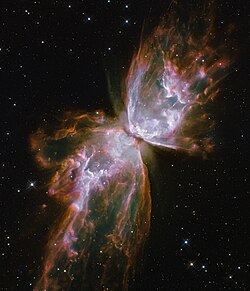NGC 6302
| NGC 6302 | |
 NGC 6302 | |
| Observationsdata | |
|---|---|
| Typ | Bipolär planetarisk nebulosa |
| Stjärnbild | Skorpionen |
| Rektascension | 17t 13m 44s |
| Deklination | -37° 06′ 16″[1] |
| Avstånd | 3400 ± 500 ljusår |
| Skenbar storlek | >3,0 bågminuter |
| Skenbar magnitud | +7,1 |
| Fysiska egenskaper | |
| Radie | >1,5 ± 0,2 ljusår |
| Absolut magnitud | -3,0 ± 0,4 |
| Upptäckt | |
| Upptäcktsår | 1880 |
| Upptäckare | Edward Barnard (tidigaste kända studie 1907) |
| Andra beteckningar | |
| Caldwell 69, Hen 2-204, PN G349.5+01.0, SH 1-3, CD-36 11341, IRAS 17103-3702, PN Sa 2-180, SH 2-6, CPC 18 8579, JCMTSF J171344.6-370608, PN ARO 502, WRAY 16-259, ESO 392-5, MSX5C G349.5082+01.0551, PN VV' 168, CAB2011 G349.50+1.05, GCRV 9926, PN VV 94, KC97c G349.5+01.1, GSC 07373-00818, OH 349.51 +1.06, RCW 124, LFO93 1710-37, GUM 60, OHPN 1, SCHD 190, HD 155520, PK 349+01 1, SCM 136[1] | |
| Se även: Nebulosor, Lista över nebulosor | |
NGC 6302 eller Caldwell 69 är en bipolär planetarisk nebulosa i stjärnbilden Skorpionen. Eftersom den ingår i New General Catalogue har objektet varit känt sedan åtminstone 1888. 1907 studerades och beskrevs den av Edward Barnard. NGC 6302 kallas även för fjärilsnebulosan.
Den centrala stjärnan i gas- och stoftmolnet har inte observerats, men NGC 6302 spektrum tyder på att den är mycket het. Stjärnan den bildats ur måste därmed ha varit stor, ett par gånger större än solen.
NGC 6302 har fotograferats av rymdteleskopet Hubble, senast på serviceuppdraget i september år 2009.
Referenser
- ^ [a b] ”Basic data: NGC 6302 -- Planetary Nebula”. Centre de Données astronomiques de Strasbourg. http://simbad.u-strasbg.fr/simbad/sim-basic?Ident=NGC+6302&submit=SIMBAD+search. Läst 1 september 2014.
Externa länkar
 Wikimedia Commons har media som rör NGC 6302.
Wikimedia Commons har media som rör NGC 6302.
Media som används på denna webbplats
Butterfly Emerges from Stellar Demise in Planetary Nebula NGC 6302
The Wide Field Camera 3 (WFC3), a new camera aboard NASA's Hubble Space Telescope, snapped this image of the planetary nebula, catalogued as NGC 6302, but more popularly called the Bug Nebula or the Butterfly Nebula. WFC3 was installed by NASA astronauts in May 2009, during the servicing mission to upgrade and repair the 19-year-old Hubble telescope.
NGC 6302 lies within our Milky Way galaxy, roughly 3,800 light-years away in the constellation Scorpius. The glowing gas is the star's outer layers, expelled over about 2,200 years. The "butterfly" stretches for more than two light-years, which is about half the distance from the Sun to the nearest star, Alpha Centauri.
The central star itself cannot be seen, because it is hidden within a doughnut-shaped ring of dust, which appears as a dark band pinching the nebula in the center. The thick dust belt constricts the star's outflow, creating the classic "bipolar" or hourglass shape displayed by some planetary nebulae.
The star's surface temperature is estimated to be about 400,000 degrees Fahrenheit, making it one of the hottest known stars in our galaxy. Spectroscopic observations made with ground-based telescopes show that the gas is roughly 36,000 degrees Fahrenheit, which is unusually hot compared to a typical planetary nebula.
The WFC3 image reveals a complex history of ejections from the star. The star first evolved into a huge red-giant star, with a diameter of about 1,000 times that of our Sun. It then lost its extended outer layers. Some of this gas was cast off from its equator at a relatively slow speed, perhaps as low as 20,000 miles an hour, creating the doughnut-shaped ring. Other gas was ejected perpendicular to the ring at higher speeds, producing the elongated "wings" of the butterfly-shaped structure. Later, as the central star heated up, a much faster stellar wind, a stream of charged particles traveling at more than 2 million miles an hour, plowed through the existing wing-shaped structure, further modifying its shape.
The image also shows numerous finger-like projections pointing back to the star, which may mark denser blobs in the outflow that have resisted the pressure from the stellar wind.
The nebula's reddish outer edges are largely due to light emitted by nitrogen, which marks the coolest gas visible in the picture. WFC3 is equipped with a wide variety of filters that isolate light emitted by various chemical elements, allowing astronomers to infer properties of the nebular gas, such as its temperature, density, and composition.
The white-colored regions are areas where light is emitted by sulfur. These are regions where fast-moving gas overtakes and collides with slow-moving gas that left the star at an earlier time, producing shock waves in the gas (the bright white edges on the sides facing the central star). The white blob with the crisp edge at upper right is an example of one of those shock waves.
NGC 6302 was imaged on July 27, 2009, with Hubble's Wide Field Camera 3 in ultraviolet and visible light. Filters that isolate emissions from oxygen, helium, hydrogen, nitrogen, and sulfur from the planetary nebula were used to create this composite image.
These Hubble observations of the planetary nebula NGC 6302 are part of the Hubble Servicing Mission 4 Early Release Observations.
